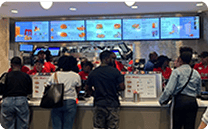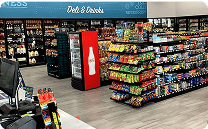In This article
Thresholding is a critical technique used in data analysis and monitoring systems to simplify decision-making and enhance responsiveness. By defining acceptable ranges for key metrics or activities, businesses can automatically detect when conditions fall outside normal boundaries and take timely action.
Examples of Thresholding Applications
In security and operational environments, thresholding allows for real-time oversight without requiring continuous manual observation. Instead of reviewing every transaction, movement, or event, businesses set specific thresholds—numeric limits or rule-based conditions—defining acceptable performance, behavior, or activity. When data points cross these limits, systems can immediately flag the situation for review, generate alerts, or initiate automated responses.
Examples of thresholding applications include:
- Setting the maximum voided transactions per shift before management receives a notification.
- Defining acceptable temperature ranges for food storage, with alerts if readings move outside the safe zone.
- Monitoring access control systems to detect multiple failed badge attempts within a short time frame.
- Establishing limits for people-counting analytics to highlight overcrowding or occupancy violations.
- Creating a threshold for cash drawer openings without sales helps identify potential cash handling risks.
Thresholding Advantages
Thresholding is especially useful in video analytics, where it can monitor behaviors such as the number of people in a restricted area, the duration of loitering in sensitive zones, or motion detected after hours. By automatically focusing attention on deviations, thresholding improves the efficiency and effectiveness of surveillance systems.
The advantages of thresholding include:
- Faster response times by surfacing critical issues without delay.
- Prioritized monitoring focusing on events most likely to impact security or operations.
- Reduced manual workload by minimizing the need to review normal, uneventful data.
- Improved operational consistency by maintaining clear, measurable standards.
- Enhanced reporting and analysis, with structured data tied to specific threshold breaches.
Thresholds can be static—set once based on known operational patterns—or dynamic, adjusting automatically based on historical data and evolving conditions. For example, a dynamic threshold might increase allowable customer capacity during holiday shopping but tighten it during slower seasons.
Setting effective thresholds requires careful calibration. Too strict thresholds can generate excessive false alarms, while those that are too lenient may allow real issues to go unnoticed. Businesses should periodically review and adjust thresholds based on operational changes, risk assessments, and system performance.
Thresholding also plays a vital role in proactive management. By analyzing trends in threshold breaches over time, businesses can identify underlying problems, such as insufficient staffing, process breakdowns, or emerging security risks, and take corrective action before larger issues arise.
In multi-location businesses, centralized threshold management allows leadership to maintain consistent standards while adapting thresholds to each site’s unique operational realities.
Stay Alert with Smart Thresholding from DTiQ
DTiQ empowers businesses to set intelligent thresholds across transaction data, surveillance analytics, and operational metrics. The 360iQ platform helps monitor what matters most—flagging outliers, surfacing risks, and supporting faster, more focused responses. With DATAiQ, thresholding becomes a powerful tool for maintaining security, operational excellence, and compliance across all locations. Want to learn more? Schedule a demo.





























